Data modeling is a powerful tool that can help businesses make more informed business decisions and expedite their growth. According to a 2022 Data & Analytics study, 88% of business leaders agree that data has the potential to fundamentally change the way their company does business over the next 1-3 years.
In this article, we’ll provide 7 tactics to maximize the power of data modeling and give you the edge of your competition. Whether you’re a business leader looking to create a data model or an engineer looking to optimize data management, you’ll learn how to use business data modeling and how to get the most out of it.
What is a data model?
A data model is a conceptual representation of the data relationships in a system or database. It is typically used to represent the structure of a database, including its entities and their attributes, as well as the relationships between them. Data models are used to define the logical structure of a database and are to facilitate communication amongst the system’s stakeholders. There are many types of data models including:
- Conceptual data model: High-level representation of the data relationships without technical details such as data storage
- Logical data model: Detailed view of data entities, relationships, constraints, and business rules
- Physical data model: Describes how data is stored in the database, including the physical storage structures such as tables, columns, indexes, and partitions.
- Relational data model: Represents data as a collection of tables with each table consisting of a set of rows and columns, with the relationships between the tables defined by primary and foreign keys.
What is business data modeling?
Business data modeling is the process of creating a structured representation of an organization's data, processes, and operations with the goal of providing greater visibility into the business and support strategic decision making. This typically includes:
- Identifying and defining the entities and attributes that represent the data within the organization
- Mapping out the relationships between the entities to show how they are connected
- Creating a set of data governance rules for how the data is managed
- Using this information to design and develop systems that support the organization's strategic decision-making and operational processes
Why is data modeling important?
Having a comprehensive data modeling strategy is important for a business because it helps to create a structured representation of the organization's data, operations, and processes. The data modeling process can provide benefits to the business including:
- Improved data management: By creating a structured representation of the organization's data, data modeling helps businesses to better manage their data, ensuring that it is accurate, error-free, consistent, and easily accessible.
- Enhanced business and IT collaboration: Having data models in place can provide a structure for collaboration between your IT team and business stakeholders.
- Process optimization: Data models can expose opportunities for improving business processes by defining data needs and uses.
- Better decision making: Data modeling helps businesses to make more informed decisions by providing insights into the organization's data, identifying trends, and predicting outcomes.
- Cost savings: By identifying areas for improvement, data models can help save time and money on IT and process investments through appropriate planning up front.
Challenges of business data modeling
While data modeling can provide numerous benefits, it’s not always a simple process. Many businesses face the following challenges when investing in data modeling:
- Inaccurate data: Using incorrect data in your data models can lead to incorrect assumptions. Additionally, it can lead to time and resources being wasted on analyzing and interpreting data that is not accurate.
- Data management complexity: Data management can become complex as data sets grow in size and more teams and business units become involved in the data modeling process.
- Balancing normalization and denormalization: It's difficult to balance normalization and denormalization in data modeling because each approach has its own advantages and disadvantages, depending on the context and goals of the data model.
- Communicating and collaborating with stakeholders: Data modeling is not a solo activity but a collaborative one. Each stakeholder has their own perspective, expectations, and needs regarding the data model, so effective communication and collaboration is essential to ensure alignment and agreement on the data model objectives.
- Handling data changes and evolution: Data is not static, but dynamic and evolving. Business needs, user feedback, market trends, and technology updates all contribute to the changes and evolution of data.
- Data security: Ensuring data security is an essential component of the data modeling process. Businesses must ensure that the data they are collecting, storing, and using is secure and protected from unauthorized access.
7 proven tactics to supercharge data modeling in your business
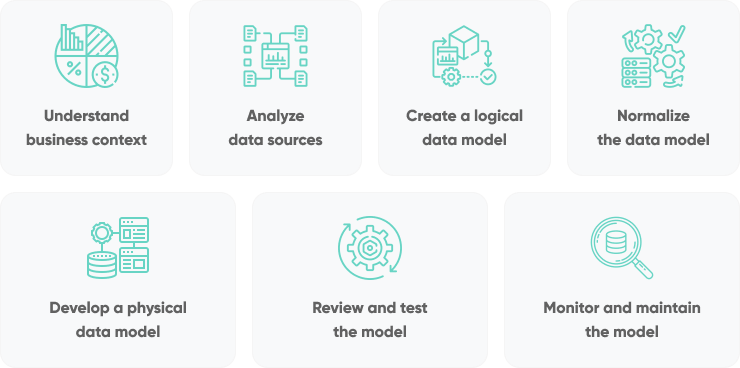
Data modeling is a critical part of managing a successful business, but as we have discussed, it doesn’t come without its challenges. In this section, we will explore 7 proven strategies to supercharge your data modeling techniques and help you get the most out of your data.
Understand the business context
High quality data models are always rooted in a deep understanding of the business context. By understanding the business context, businesses can better align their data models with their business objectives and requirements, leading to more accurate and effective decision-making. To achieve this, we recommend you:
- Identify key stakeholders: Identify key stakeholders who will be impacted by the data model, including business leaders, data analysts, and end-users.
- Define business requirements: Define the business requirements for the data model, including the business objectives, use cases, and decision-making processes.
- Map business processes: Map out the business processes that will be impacted by the data model, and identify any areas where the model can improve efficiency and effectiveness.
- Identify and define entities: Identify and define the entities (i.e. objects and subjects) needed to model the data. This includes defining the attributes and characteristics of each entity.
- Understand entity relationships: Understand the relationships between those entities. This includes identifying one-to-one, one-to-many, and many-to-many relationships between entities.
- Consider data constraints: Consider data constraints or restrictions. This includes defining data types, setting data ranges, and identifying any mandatory fields.
PRO TIP: Using the right data modeling tools can help you to streamline the data modeling process and achieve a practical visual representation of the data. Data flow diagrams (DFDs) are a useful tool for visualizing and documenting the flow of data between processes and systems. By understanding the data dependencies, businesses can identify potential errors and redundancies, as well as areas for improvement. A DFD could look something like this
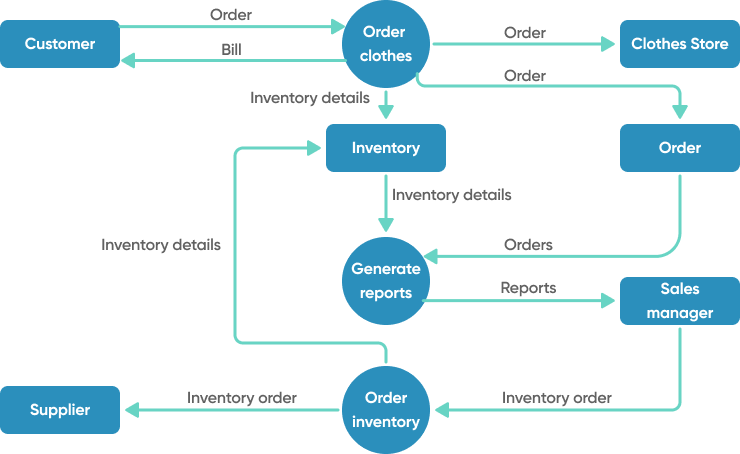
Analyze the data sources
Analyzing the existing data (whether sales, operational, or customer data) helps to understand the data structures and content, as well as any gaps or inconsistencies that should be taken into account when developing the data model. This can help not only to improve the quality of the data and its associated models, but also to develop a better understanding of the underlying data and how it can be used to drive organizational performance and decision-making. To ensure the most effective use of data modeling, businesses should:
- Identify all relevant data sources: Identify the key data sources and data fields that are important to the organization’s performance and decision-making. This includes internal sources such as databases and spreadsheets, as well as external sources such as third-party data providers or publicly available data sets.
- Evaluate data quality: Evaluate the quality of each data source. This includes assessing factors such as accuracy, completeness, and consistency. Identify gaps or inconsistencies that need to be addressed before the data can be used in a data model.
- Identify data relationships: Identify relationships between data sources. This includes understanding how data from different sources can be integrated to provide a more complete view of the business.
PRO TIP: Businesses should consider using data profiling and analysis tools to quickly identify data quality issues and gain a better understanding of their data sources and/or data warehouse. These tools can provide data-driven recommendations for improving data quality and accuracy.
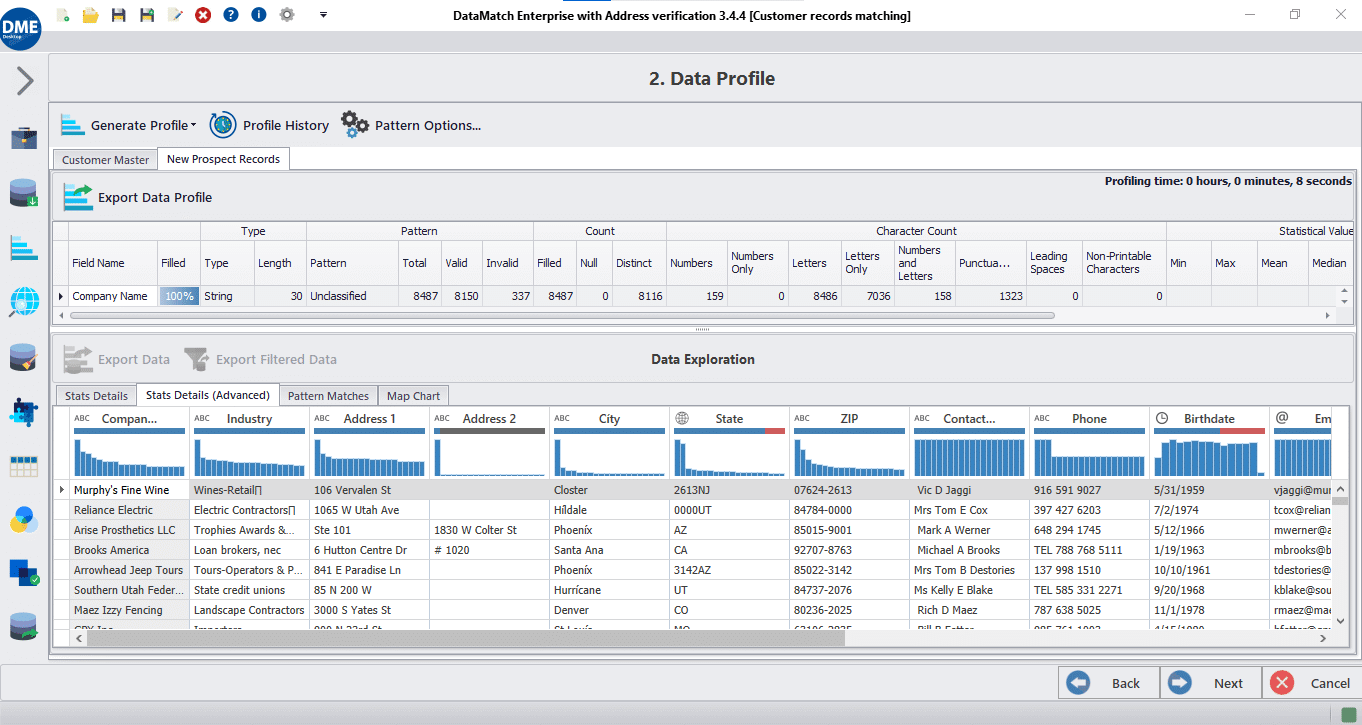
Create a logical data model
While there are many types of data models to choose from, including a conceptual model, relational model, and physical model, a logical model provides a great starting point for most teams that are beginning to invest in data modeling. This is because logical data models provide a conceptual view of data without any implementation specifics, making it a highly flexible and adaptable tool for organizing complex data structures.
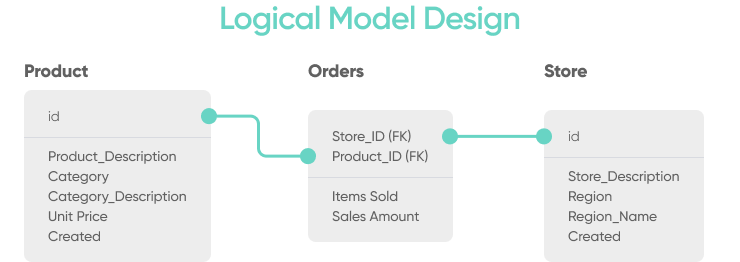
A good logical data model defines an overview of the data and how it is used by the business. It should be organized in such a way that the relationships between the data elements are clearly delineated, and any changes or additions to the data can be made easily. The model should also be able to take into account any future changes in the way the data is used by the business.
To create a logical data model:
- Identify the business requirements for the data model by talking to stakeholders and analyzing business processes.
- Identify the entities (i.e. objects or subjects) in the business environment that need to be modeled, such as customers, products, and orders.
- Define the relationships between the identified entities, such as one-to-one, one-to-many, or many-to-many relationships.
- Identify the attributes (i.e. characteristics or properties) for each entity, such as name, address, and date of birth.
- Normalize the data to ensure that the data is organized efficiently and accurately, while minimizing redundancy and data inconsistencies. (more on this in the next section!)
- Review and refine the logical model to ensure that it meets the performance, scalability, and data storage requirements of the application.
PRO TIP: Use an Entity-Relationship Diagram (ERD) to provide a visual representation of the database structure, identify data requirements, facilitate communication between stakeholders, and improve data quality. ERDs are an essential tool for businesses to ensure that the database accurately represents the organization's data needs.
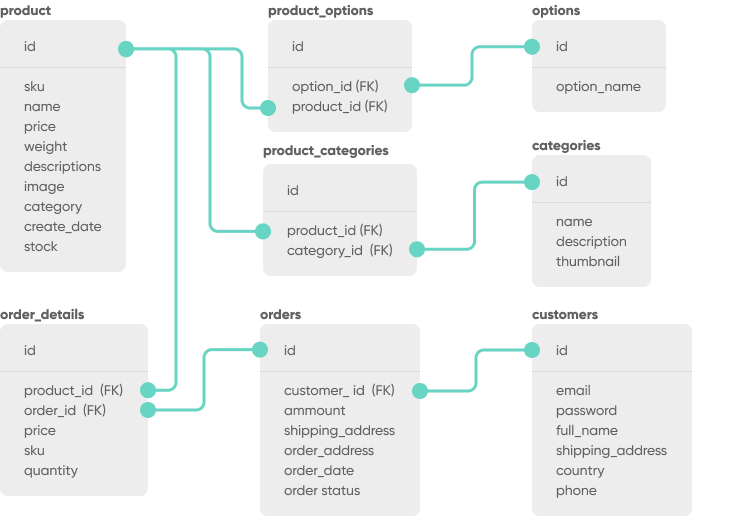
Normalize the data model
Normalization is the process of organizing data into related tables and ensuring that the data is stored in a consistent, logical format. Normalizing your data minimizes redundancy and inconsistency of data by reducing the data to its most basic form. It is an important step in ensuring data integrity and accuracy during the data modelling process. To normalize a data model, businesses should:
- Identify the primary key: A primary key is a unique identifier for each row in a table. It should be an attribute that can be used to distinguish one row from another.
- Eliminate redundant data: Data should not be repeated in multiple tables. Instead it should be stored in one table and referenced in other tables as needed.
- Create relationships between tables: Establishing relationships between tables allows data to be linked and shared across multiple tables.
- Ensure data integrity: Data integrity should be enforced through the use of constraints, triggers, and other means.
For example, a data table that is not normalized might look something like this:

To normalize the data, we should break the database into multiple tables as you see below. This helps to reduce redundancy and organize the data in a way that can more easily be referenced by other databases. The primary keys highlighted in blue and red help to define the relationships between tables.
PRO TIP: When normalizing data for data modeling, it is important to start with the most essential and basic information and work up to the more complex, less essential data. This will help to keep the model simple and efficient, avoiding unnecessary complexity.
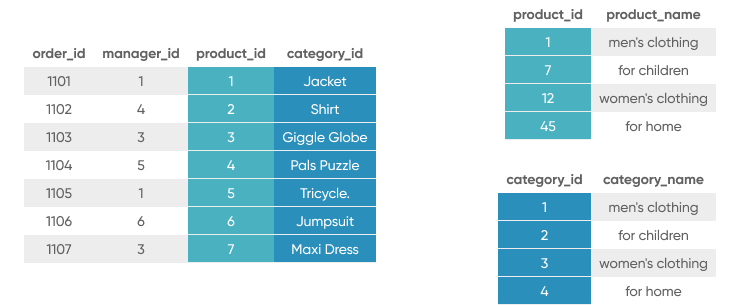
Develop a physical data model
If you already have a logical model in place, you can use it to develop a physical model. Physical models can help teams model data in a way that represents the actual structure of the data in the database. A physical model is a type of data model that defines the technical implementation details of the data model, such as data types, indexing options, and storage details. It is created after the logical model and takes into account the physical constraints of the database management system (DBMS) and hardware infrastructure.
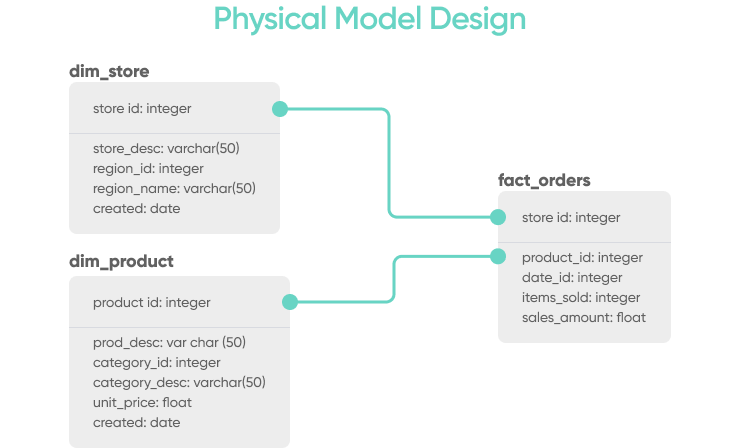
To develop a physical model of data:
- Analyze the logical model to understand the data structure and relationships.
- Identify physical data storage requirements for the database. This includes determining the type of database management system (DBMS) to be used, the storage requirements for each data element, and the expected volume of data.
- Determine data access methods for the database. This includes identifying the types of queries that will be used, the indexing strategy, and the performance requirements.
- Develop the physical schema, using the logical model as a basis.
- Review and refine the physical model to ensure that it meets the performance, scalability, and data storage requirements of the application.
Review and test the model
When using data modeling, it is essential to review and test the model thoroughly to ensure accuracy and business requirements are met. To do so, businesses should:
- Review the model: The first step is to review the data model to ensure that it meets the business requirements and that all necessary data elements have been included.
- Identify test cases: Create a set of test cases to validate the accuracy and completeness of the data model. This will help to identify any issues or errors that need to be addressed.
- Test the model: Use the test cases to test the data model thoroughly. This should include testing the model's functionality, performance, and data integrity.
- Validate the results: Review the results of the testing to ensure that the data model is functioning as expected and that it meets the business requirements.
- Iterate as needed: If issues or errors are identified during testing, make necessary changes to the data model and repeat the testing process until the model is fully validated.
PRO TIP: Establish a testing protocol that includes unit testing, integration testing, and user acceptance testing. Make sure to test all aspects of the model, as well as any changes that may have been made during the model development process.

Monitor and maintain the model
Creating data models is not a one and done process. After the model is in production, monitor and maintain it over time. Monitoring and maintaining an existing data model is a critical part of ensuring that the data remains relevant and accurate over time. To ensure the model remains effective, businesses should:
- Regularly review the data models to ensure that they still meet the business needs.
- Measure model performance to ensure that it is still producing the desired results.
- Monitor for any changes in the business environment or requirements and adjust the model accordingly.
- Regularly review any new data sources and determine if they should be incorporated into the model.
- Train users on the proper use of the data model and establish best practices to ensure that data is entered and managed consistently.
- Regularly communicate with stakeholders to ensure that the data model continues to meet the needs of the business and to identify opportunities for improvement.
Conclusion
Data modeling is a powerful tool that can help businesses make informed decisions, optimize processes, and achieve their strategic objectives. By using the tactics discussed in this article, businesses can maximize the power of data modeling, streamline their data management, and get ahead of the competition.
If you need help maximizing the effectiveness of your data strategy, our data engineering company would be happy to help!
At SoftKraft we offer software development consulting services to help teams modernize their data strategy and start making the most of their business data.
We’ll work closely with you to understand your unique business challenges and map out a strategic solution that addresses your specific needs, so you can maximize your software ROI. At the end of the day, the only metric that matters to us is project success.







![Effective RFP for Software Development [Template & Process]](/uploads/blog/rfp-for-software-development/rfp-for-software development.png)